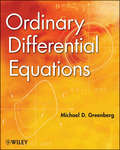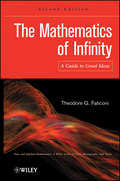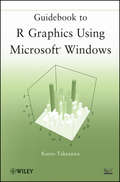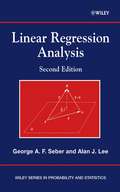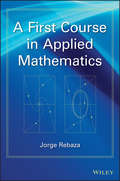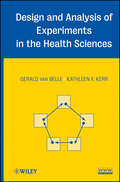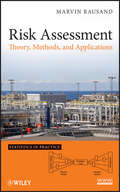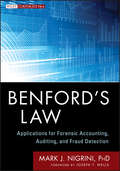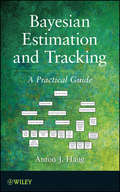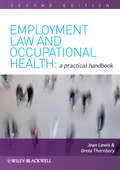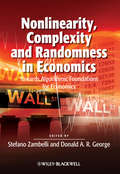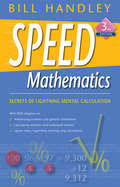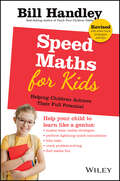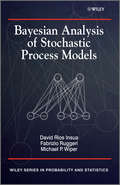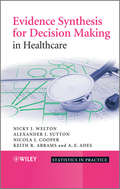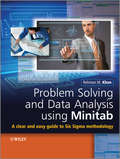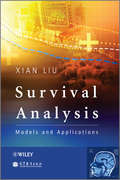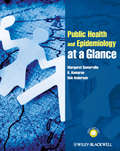- Table View
- List View
Ordinary Differential Equations
by Michael D. GreenbergFeatures a balance between theory, proofs, and examples and provides applications across diverse fields of study Ordinary Differential Equations presents a thorough discussion of first-order differential equations and progresses to equations of higher order. The book transitions smoothly from first-order to higher-order equations, allowing readers to develop a complete understanding of the related theory. Featuring diverse and interesting applications from engineering, bioengineering, ecology, and biology, the book anticipates potential difficulties in understanding the various solution steps and provides all the necessary details. Topical coverage includes: First-Order Differential Equations Higher-Order Linear Equations Applications of Higher-Order Linear Equations Systems of Linear Differential Equations Laplace Transform Series Solutions Systems of Nonlinear Differential Equations In addition to plentiful exercises and examples throughout, each chapter concludes with a summary that outlines key concepts and techniques. The book's design allows readers to interact with the content, while hints, cautions, and emphasis are uniquely featured in the margins to further help and engage readers. Written in an accessible style that includes all needed details and steps, Ordinary Differential Equations is an excellent book for courses on the topic at the upper-undergraduate level. The book also serves as a valuable resource for professionals in the fields of engineering, physics, and mathematics who utilize differential equations in their everyday work. An Instructors Manual is available upon request. Email sfriedman@wiley.com for information. There is also a Solutions Manual available. The ISBN is 9781118398999.
The Mathematics of Infinity: A Guide to Great Ideas (Pure and Applied Mathematics: A Wiley Series of Texts, Monographs and Tracts #111)
by Theodore G. FaticoniPraise for the First Edition ". . . an enchanting book for those people in computer science or mathematics who are fascinated by the concept of infinity."—Computing Reviews ". . . a very well written introduction to set theory . . . easy to read and well suited for self-study . . . highly recommended."—Choice The concept of infinity has fascinated and confused mankind for centuries with theories and ideas that cause even seasoned mathematicians to wonder. The Mathematics of Infinity: A Guide to Great Ideas, Second Edition uniquely explores how we can manipulate these ideas when our common sense rebels at the conclusions we are drawing. Continuing to draw from his extensive work on the subject, the author provides a user-friendly presentation that avoids unnecessary, in-depth mathematical rigor. This Second Edition provides important coverage of logic and sets, elements and predicates, cardinals as ordinals, and mathematical physics. Classic arguments and illustrative examples are provided throughout the book and are accompanied by a gradual progression of sophisticated notions designed to stun readers' intuitive view of the world. With an accessible and balanced treatment of both concepts and theory, the book focuses on the following topics: Logic, sets, and functions Prime numbers Counting infinite sets Well ordered sets Infinite cardinals Logic and meta-mathematics Inductions and numbers Presenting an intriguing account of the notions of infinity, The Mathematics of Infinity: A Guide to Great Ideas, Second Edition is an insightful supplement for mathematics courses on set theory at the undergraduate level. The book also serves as a fascinating reference for mathematically inclined individuals who are interested in learning about the world of counterintuitive mathematics.
Guidebook to R Graphics Using Microsoft Windows
by Kunio TakezawaIntroduces the graphical capabilities of R to readers new to the software Due to its flexibility and availability, R has become the computing software of choice for statistical computing and generating graphics across various fields of research. Guidebook to R Graphics Using Microsoft® Windows offers a unique presentation of R, guiding new users through its many benefits, including the creation of high-quality graphics. Beginning with getting the program up and running, this book takes readers step by step through the process of creating histograms, boxplots, strip charts, time series graphs, steam-and-leaf displays, scatterplot matrices, and map graphs. In addition, the book presents: Tips for establishing, saving, and printing graphs along with essential base-package plotting functions Interactive R programs for carrying out common tasks such as inputting values, moving data on a natural spline, adjusting three-dimensional graphs, and understanding simple and local linear regression Various external packages for R that help to create more complex graphics like rimage, gplots, ggplot2, tripack, rworldmap, and plotrix packages Throughout the book, concise explanations of key concepts of R graphics assist readers in carrying out the presented procedures, and any coverage of functions is clearly written out and displayed in the text as demos. The discussed techniques are accompanied by a wealth of screenshots and graphics with related R code available on the book's FTP site, and numerous exercises allow readers to test their understanding of the presented material. Guidebook to R Graphics Using Microsoft® Windows is a valuable resource for researchers in the fields of statistics, public health, business, and the life and social sciences who use or would like to learn how to use R to create visual representations of data. The book can also be used as a supplement for courses on statistical analysis at the upper-undergraduate level.
Guidebook to R Graphics Using Microsoft Windows
by Kunio TakezawaIntroduces the graphical capabilities of R to readers new to the software Due to its flexibility and availability, R has become the computing software of choice for statistical computing and generating graphics across various fields of research. Guidebook to R Graphics Using Microsoft® Windows offers a unique presentation of R, guiding new users through its many benefits, including the creation of high-quality graphics. Beginning with getting the program up and running, this book takes readers step by step through the process of creating histograms, boxplots, strip charts, time series graphs, steam-and-leaf displays, scatterplot matrices, and map graphs. In addition, the book presents: Tips for establishing, saving, and printing graphs along with essential base-package plotting functions Interactive R programs for carrying out common tasks such as inputting values, moving data on a natural spline, adjusting three-dimensional graphs, and understanding simple and local linear regression Various external packages for R that help to create more complex graphics like rimage, gplots, ggplot2, tripack, rworldmap, and plotrix packages Throughout the book, concise explanations of key concepts of R graphics assist readers in carrying out the presented procedures, and any coverage of functions is clearly written out and displayed in the text as demos. The discussed techniques are accompanied by a wealth of screenshots and graphics with related R code available on the book's FTP site, and numerous exercises allow readers to test their understanding of the presented material. Guidebook to R Graphics Using Microsoft® Windows is a valuable resource for researchers in the fields of statistics, public health, business, and the life and social sciences who use or would like to learn how to use R to create visual representations of data. The book can also be used as a supplement for courses on statistical analysis at the upper-undergraduate level.
Linear Regression Analysis (Wiley Series in Probability and Statistics #329)
by George A. Seber Alan J. LeeConcise, mathematically clear, and comprehensive treatment of the subject. * Expanded coverage of diagnostics and methods of model fitting. * Requires no specialized knowledge beyond a good grasp of matrix algebra and some acquaintance with straight-line regression and simple analysis of variance models. * More than 200 problems throughout the book plus outline solutions for the exercises. * This revision has been extensively class-tested.
A First Course in Applied Mathematics
by Jorge RebazaExplore real-world applications of selected mathematical theory, concepts, and methods Exploring related methods that can be utilized in various fields of practice from science and engineering to business, A First Course in Applied Mathematics details how applied mathematics involves predictions, interpretations, analysis, and mathematical modeling to solve real-world problems. Written at a level that is accessible to readers from a wide range of scientific and engineering fields, the book masterfully blends standard topics with modern areas of application and provides the needed foundation for transitioning to more advanced subjects. The author utilizes MATLAB® to showcase the presented theory and illustrate interesting real-world applications to Google's web page ranking algorithm, image compression, cryptography, chaos, and waste management systems. Additional topics covered include: Linear algebra Ranking web pages Matrix factorizations Least squares Image compression Ordinary differential equations Dynamical systems Mathematical models Throughout the book, theoretical and applications-oriented problems and exercises allow readers to test their comprehension of the presented material. An accompanying website features related MATLAB® code and additional resources. A First Course in Applied Mathematics is an ideal book for mathematics, computer science, and engineering courses at the upper-undergraduate level. The book also serves as a valuable reference for practitioners working with mathematical modeling, computational methods, and the applications of mathematics in their everyday work.
Design and Analysis of Experiments in the Health Sciences
by Gerald van Belle Kathleen F. KerrAn accessible and practical approach to the design and analysis of experiments in the health sciences Design and Analysis of Experiments in the Health Sciences provides a balanced presentation of design and analysis issues relating to data in the health sciences and emphasizes new research areas, the crucial topic of clinical trials, and state-of-the- art applications. Advancing the idea that design drives analysis and analysis reveals the design, the book clearly explains how to apply design and analysis principles in animal, human, and laboratory experiments while illustrating topics with applications and examples from randomized clinical trials and the modern topic of microarrays. The authors outline the following five types of designs that form the basis of most experimental structures: Completely randomized designs Randomized block designs Factorial designs Multilevel experiments Repeated measures designs A related website features a wealth of data sets that are used throughout the book, allowing readers to work hands-on with the material. In addition, an extensive bibliography outlines additional resources for further study of the presented topics. Requiring only a basic background in statistics, Design and Analysis of Experiments in the Health Sciences is an excellent book for introductory courses on experimental design and analysis at the graduate level. The book also serves as a valuable resource for researchers in medicine, dentistry, nursing, epidemiology, statistical genetics, and public health.
Design and Analysis of Experiments in the Health Sciences
by Gerald van Belle Kathleen F. KerrAn accessible and practical approach to the design and analysis of experiments in the health sciences Design and Analysis of Experiments in the Health Sciences provides a balanced presentation of design and analysis issues relating to data in the health sciences and emphasizes new research areas, the crucial topic of clinical trials, and state-of-the- art applications. Advancing the idea that design drives analysis and analysis reveals the design, the book clearly explains how to apply design and analysis principles in animal, human, and laboratory experiments while illustrating topics with applications and examples from randomized clinical trials and the modern topic of microarrays. The authors outline the following five types of designs that form the basis of most experimental structures: Completely randomized designs Randomized block designs Factorial designs Multilevel experiments Repeated measures designs A related website features a wealth of data sets that are used throughout the book, allowing readers to work hands-on with the material. In addition, an extensive bibliography outlines additional resources for further study of the presented topics. Requiring only a basic background in statistics, Design and Analysis of Experiments in the Health Sciences is an excellent book for introductory courses on experimental design and analysis at the graduate level. The book also serves as a valuable resource for researchers in medicine, dentistry, nursing, epidemiology, statistical genetics, and public health.
Risk Assessment: Theory, Methods, and Applications (Statistics in Practice #115)
by Marvin RausandAn introduction to risk assessment that utilizes key theory and state-of-the-art applications With its balanced coverage of theory and applications along with standards and regulations, Risk Assessment: Theory, Methods, and Applications serves as a comprehensive introduction to the topic. The book serves as a practical guide to current risk analysis and risk assessment, emphasizing the possibility of sudden, major accidents across various areas of practice from machinery and manufacturing processes to nuclear power plants and transportation systems. The author applies a uniform framework to the discussion of each method, setting forth clear objectives and descriptions, while also shedding light on applications, essential resources, and advantages and disadvantages. Following an introduction that provides an overview of risk assessment, the book is organized into two sections that outline key theory, methods, and applications. Introduction to Risk Assessment defines key concepts and details the steps of a thorough risk assessment along with the necessary quantitative risk measures. Chapters outline the overall risk assessment process, and a discussion of accident models and accident causation offers readers new insights into how and why accidents occur to help them make better assessments. Risk Assessment Methods and Applications carefully describes the most relevant methods for risk assessment, including preliminary hazard analysis, HAZOP, fault tree analysis, and event tree analysis. Here, each method is accompanied by a self-contained description as well as workflow diagrams and worksheets that illustrate the use of discussed techniques. Important problem areas in risk assessment, such as barriers and barrier analysis, human errors, and human reliability, are discussed along with uncertainty and sensitivity analysis. Each chapter concludes with a listing of resources for further study of the topic, and detailed appendices outline main results from probability and statistics, related formulas, and a listing of key terms used in risk assessment. A related website features problems that allow readers to test their comprehension of the presented material and supplemental slides to facilitate the learning process. Risk Assessment is an excellent book for courses on risk analysis and risk assessment at the upper-undergraduate and graduate levels. It also serves as a valuable reference for engineers, researchers, consultants, and practitioners who use risk assessment techniques in their everyday work.
Benford's Law: Applications for Forensic Accounting, Auditing, and Fraud Detection (Wiley Corporate F&A #616)
by Mark J. NigriniA powerful new tool for all forensic accountants, or anyone who analyzes data that may have been altered Benford's Law gives the expected patterns of the digits in the numbers in tabulated data such as town and city populations or Madoff's fictitious portfolio returns. Those digits, in unaltered data, will not occur in equal proportions; there is a large bias towards the lower digits, so much so that nearly one-half of all numbers are expected to start with the digits 1 or 2. These patterns were originally discovered by physicist Frank Benford in the early 1930s, and have since been found to apply to all tabulated data. Mark J. Nigrini has been a pioneer in applying Benford's Law to auditing and forensic accounting, even before his groundbreaking 1999 Journal of Accountancy article introducing this useful tool to the accounting world. In Benford's Law, Nigrini shows the widespread applicability of Benford's Law and its practical uses to detect fraud, errors, and other anomalies. Explores primary, associated, and advanced tests, all described with data sets that include corporate payments data and election data Includes ten fraud detection studies, including vendor fraud, payroll fraud, due diligence when purchasing a business, and tax evasion Covers financial statement fraud, with data from Enron, AIG, and companies that were the target of hedge fund short sales Looks at how to detect Ponzi schemes, including data on Madoff, Waxenberg, and more Examines many other applications, from the Clinton tax returns and the charitable gifts of Lehman Brothers to tax evasion and number invention Benford's Law has 250 figures and uses 50 interesting authentic and fraudulent real-world data sets to explain both theory and practice, and concludes with an agenda and directions for future research. The companion website adds additional information and resources.
Benford's Law: Applications for Forensic Accounting, Auditing, and Fraud Detection (Wiley Corporate F&A #615)
by Mark J. NigriniA powerful new tool for all forensic accountants, or anyone who analyzes data that may have been altered Benford's Law gives the expected patterns of the digits in the numbers in tabulated data such as town and city populations or Madoff's fictitious portfolio returns. Those digits, in unaltered data, will not occur in equal proportions; there is a large bias towards the lower digits, so much so that nearly one-half of all numbers are expected to start with the digits 1 or 2. These patterns were originally discovered by physicist Frank Benford in the early 1930s, and have since been found to apply to all tabulated data. Mark J. Nigrini has been a pioneer in applying Benford's Law to auditing and forensic accounting, even before his groundbreaking 1999 Journal of Accountancy article introducing this useful tool to the accounting world. In Benford's Law, Nigrini shows the widespread applicability of Benford's Law and its practical uses to detect fraud, errors, and other anomalies. Explores primary, associated, and advanced tests, all described with data sets that include corporate payments data and election data Includes ten fraud detection studies, including vendor fraud, payroll fraud, due diligence when purchasing a business, and tax evasion Covers financial statement fraud, with data from Enron, AIG, and companies that were the target of hedge fund short sales Looks at how to detect Ponzi schemes, including data on Madoff, Waxenberg, and more Examines many other applications, from the Clinton tax returns and the charitable gifts of Lehman Brothers to tax evasion and number invention Benford's Law has 250 figures and uses 50 interesting authentic and fraudulent real-world data sets to explain both theory and practice, and concludes with an agenda and directions for future research. The companion website adds additional information and resources.
Bayesian Estimation and Tracking: A Practical Guide
by Anton J. HaugA practical approach to estimating and tracking dynamic systems in real-worl applications Much of the literature on performing estimation for non-Gaussian systems is short on practical methodology, while Gaussian methods often lack a cohesive derivation. Bayesian Estimation and Tracking addresses the gap in the field on both accounts, providing readers with a comprehensive overview of methods for estimating both linear and nonlinear dynamic systems driven by Gaussian and non-Gaussian noices. Featuring a unified approach to Bayesian estimation and tracking, the book emphasizes the derivation of all tracking algorithms within a Bayesian framework and describes effective numerical methods for evaluating density-weighted integrals, including linear and nonlinear Kalman filters for Gaussian-weighted integrals and particle filters for non-Gaussian cases. The author first emphasizes detailed derivations from first principles of eeach estimation method and goes on to use illustrative and detailed step-by-step instructions for each method that makes coding of the tracking filter simple and easy to understand. Case studies are employed to showcase applications of the discussed topics. In addition, the book supplies block diagrams for each algorithm, allowing readers to develop their own MATLAB® toolbox of estimation methods. Bayesian Estimation and Tracking is an excellent book for courses on estimation and tracking methods at the graduate level. The book also serves as a valuable reference for research scientists, mathematicians, and engineers seeking a deeper understanding of the topics.
Bayesian Estimation and Tracking: A Practical Guide
by Anton J. HaugA practical approach to estimating and tracking dynamic systems in real-worl applications Much of the literature on performing estimation for non-Gaussian systems is short on practical methodology, while Gaussian methods often lack a cohesive derivation. Bayesian Estimation and Tracking addresses the gap in the field on both accounts, providing readers with a comprehensive overview of methods for estimating both linear and nonlinear dynamic systems driven by Gaussian and non-Gaussian noices. Featuring a unified approach to Bayesian estimation and tracking, the book emphasizes the derivation of all tracking algorithms within a Bayesian framework and describes effective numerical methods for evaluating density-weighted integrals, including linear and nonlinear Kalman filters for Gaussian-weighted integrals and particle filters for non-Gaussian cases. The author first emphasizes detailed derivations from first principles of eeach estimation method and goes on to use illustrative and detailed step-by-step instructions for each method that makes coding of the tracking filter simple and easy to understand. Case studies are employed to showcase applications of the discussed topics. In addition, the book supplies block diagrams for each algorithm, allowing readers to develop their own MATLAB® toolbox of estimation methods. Bayesian Estimation and Tracking is an excellent book for courses on estimation and tracking methods at the graduate level. The book also serves as a valuable reference for research scientists, mathematicians, and engineers seeking a deeper understanding of the topics.
Employment Law and Occupational Health: A Practical Handbook
by Joan Lewis Greta Thornbory'Employment Law and Occupational Health: A Practical Handbook' provides an essential guide to best practice for all occupational health practitioners. This readable guide to the law will help to ensure both business success and respect for individual employment rights. The cost of sickness absence can present major costs and business management problems. Safeguarding health is therefore vital to both individuals and employers. 'Employment Law and Occupational Health' explores key issues in occupational health practice from pre-employment, through health surveillance and occupational health services, to termination of employment. Topics explored include ethical and confidentiality issues, discrimination, data protection, working abroad, pregnancy and maternity leave, workplace policies, drugs and alcohol testing, stress, counselling, health surveillance and professional conduct rules. This second edition has been fully revised and updated to include a number of significant changes to employment law as well as new case law decisions that have occurred since the 1st Edition was published. Essential new material has also been included around age discrimination, disability discrimination, work related stress, corporate manslaughter and work-place bullying. An accessible, practical guide to applying health law in everyday practice. For occupational health nurses and other occupational health practitioners. Addresses key employment issues from pre-employment to termination of employment. Includes case studies, procedural checklists, and template letters and forms.
Nonlinearity, Complexity and Randomness in Economics: Towards Algorithmic Foundations for Economics (Surveys of Recent Research in Economics #8)
by Stefano Zambelli Donald A. R. GeorgeNonlinearity, Complexity and Randomness in Economics presents a variety of papers by leading economists, scientists, and philosophers who focus on different aspects of nonlinearity, complexity and randomness, and their implications for economics. A theme of the book is that economics should be based on algorithmic, computable mathematical foundations. Features an interdisciplinary collection of papers by economists, scientists, and philosophers Presents new approaches to macroeconomic modelling, agent-based modelling, financial markets, and emergent complexity Reveals how economics today must be based on algorithmic, computable mathematical foundations
Nonlinearity, Complexity and Randomness in Economics: Towards Algorithmic Foundations for Economics (Surveys of Recent Research in Economics #9)
by Stefano Zambelli Donald A.R. GeorgeNonlinearity, Complexity and Randomness in Economics presents a variety of papers by leading economists, scientists, and philosophers who focus on different aspects of nonlinearity, complexity and randomness, and their implications for economics. A theme of the book is that economics should be based on algorithmic, computable mathematical foundations. Features an interdisciplinary collection of papers by economists, scientists, and philosophers Presents new approaches to macroeconomic modelling, agent-based modelling, financial markets, and emergent complexity Reveals how economics today must be based on algorithmic, computable mathematical foundations
Speed Mathematics: Secrets Skills For Quick Calculation
by Bill HandleyThis new, revised edition of the bestselling Speed Mathematics features new chapters on memorising numbers and general information, calculating statistics and compound interest, square roots, logarithms and easy trig calculations. Written so anyone can understand, this book teaches simple strategies that will enable readers to make lightning-quick calculations. People who excel at mathematics use better strategies than the rest of us; they are not necessarily more intelligent. With Speed Mathematics you'll discover methods to make maths easy and fun. This book is perfect for students, parents, teachers and anyone who enjoys working with figures and even those who are terrified of numbers!
Speed Math for Kids: Helping Children Achieve Their Full Potential
by Bill HandleyPopular Australian author and inspirational teacher, Bill Handley, has developed and, over the years, refined methods of teaching mathematics and learning strategies that have achieved amazing results. His best-selling book, Speed Mathematics convinced readers that people who excel at maths use better strategies and are not necessarily more intelligent. This book contains additional methods and applications based on the strategies taught in Speed Mathematics that make the principles clearer, encourage creative thought, and are just plain fun. The book was written for young people but people of any age will enjoy it. The book has notes throughout for parents and teachers. By following his innovative approach you will have kids playing with numbers, performing lightning quick calculations and, most of all, having fun! Bill claims: 'If you are good at maths, people think you are intelligent. People will treat you like you are a genius. Your teachers and your friends will treat you differently. You will even think differently about yourself'. The emphasis in this book is on playing with mathematics. Enjoy it. Show off what you learn and make mathematics your favourite subject.
Speed Maths for Kids: Helping Children Achieve Their Full Potential
by Bill HandleyUPDATED 2022What if you could teach your kids simple maths strategies that can be applied to almost any calculation? What if you could show them that learning maths can be fun? Popular Australian author and inspirational teacher Bill Handley&’s methods of teaching mathematics and learning strategies have achieved amazing results. In this bestselling book, he shows readers that kids who excel at maths are not necessarily more intelligent—they simply use better strategies! Speed Maths for Kids makes the methods and principles for maths calculations clearer, encourages creative thought, and is just plain fun. Now fully revised with new chapters and strategies, the book also has notes throughout for parents and teachers to help their children engage and learn more easily. Help your child: Learn to enjoy maths Tackle tests without the stress Achieve better results on quizzes, NAPLAN, and exams By following Handley&’s innovative approach, you will have kids playing with numbers, performing lightning-quick calculations and, most of all, having fun! Give your child a boost in school—and make mathematics their favourite subject.
Bayesian Analysis of Stochastic Process Models (Wiley Series in Probability and Statistics #978)
by David Insua Fabrizio Ruggeri Mike WiperBayesian analysis of complex models based on stochastic processes has in recent years become a growing area. This book provides a unified treatment of Bayesian analysis of models based on stochastic processes, covering the main classes of stochastic processing including modeling, computational, inference, forecasting, decision making and important applied models. Key features: Explores Bayesian analysis of models based on stochastic processes, providing a unified treatment. Provides a thorough introduction for research students. Computational tools to deal with complex problems are illustrated along with real life case studies Looks at inference, prediction and decision making. Researchers, graduate and advanced undergraduate students interested in stochastic processes in fields such as statistics, operations research (OR), engineering, finance, economics, computer science and Bayesian analysis will benefit from reading this book. With numerous applications included, practitioners of OR, stochastic modelling and applied statistics will also find this book useful.
Evidence Synthesis for Decision Making in Healthcare (Statistics in Practice #127)
by Nicky J. Welton Alexander J. Sutton Nicola Cooper Keith R. Abrams A. E. AdesIn the evaluation of healthcare, rigorous methods of quantitative assessment are necessary to establish interventions that are both effective and cost-effective. Usually a single study will not fully address these issues and it is desirable to synthesize evidence from multiple sources. This book aims to provide a practical guide to evidence synthesis for the purpose of decision making, starting with a simple single parameter model, where all studies estimate the same quantity (pairwise meta-analysis) and progressing to more complex multi-parameter structures (including meta-regression, mixed treatment comparisons, Markov models of disease progression, and epidemiology models). A comprehensive, coherent framework is adopted and estimated using Bayesian methods. Key features: A coherent approach to evidence synthesis from multiple sources. Focus is given to Bayesian methods for evidence synthesis that can be integrated within cost-effectiveness analyses in a probabilistic framework using Markov Chain Monte Carlo simulation. Provides methods to statistically combine evidence from a range of evidence structures. Emphasizes the importance of model critique and checking for evidence consistency. Presents numerous worked examples, exercises and solutions drawn from a variety of medical disciplines throughout the book. WinBUGS code is provided for all examples. Evidence Synthesis for Decision Making in Healthcare is intended for health economists, decision modelers, statisticians and others involved in evidence synthesis, health technology assessment, and economic evaluation of health technologies.
Problem Solving and Data Analysis Using Minitab: A Clear and Easy Guide to Six Sigma Methodology
by Rehman M. KhanSix Sigma statistical methodology using Minitab Problem Solving and Data Analysis using Minitab presents example-based learning to aid readers in understanding how to use MINITAB 16 for statistical analysis and problem solving. Each example and exercise is broken down into the exact steps that must be followed in order to take the reader through key learning points and work through complex analyses. Exercises are featured at the end of each example so that the reader can be assured that they have understood the key learning points. Key features: Provides readers with a step by step guide to problem solving and statistical analysis using Minitab 16 which is also compatible with version 15. Includes fully worked examples with graphics showing menu selections and Minitab outputs. Uses example based learning that the reader can work through at their pace. Contains hundreds of screenshots to aid the reader, along with explanations of the statistics being performed and interpretation of results. Presents the core statistical techniques used by Six Sigma Black Belts. Contains examples, exercises and solutions throughout, and is supported by an accompanying website featuring the numerous example data sets. Making Six Sigma statistical methodology accessible to beginners, this book is aimed at numerical professionals, students or academics who wish to learn and apply statistical techniques for problem solving, process improvement or data analysis whilst keeping mathematical theory to a minimum.
Problem Solving and Data Analysis Using Minitab: A Clear and Easy Guide to Six Sigma Methodology
by Rehman M. KhanSix Sigma statistical methodology using Minitab Problem Solving and Data Analysis using Minitab presents example-based learning to aid readers in understanding how to use MINITAB 16 for statistical analysis and problem solving. Each example and exercise is broken down into the exact steps that must be followed in order to take the reader through key learning points and work through complex analyses. Exercises are featured at the end of each example so that the reader can be assured that they have understood the key learning points. Key features: Provides readers with a step by step guide to problem solving and statistical analysis using Minitab 16 which is also compatible with version 15. Includes fully worked examples with graphics showing menu selections and Minitab outputs. Uses example based learning that the reader can work through at their pace. Contains hundreds of screenshots to aid the reader, along with explanations of the statistics being performed and interpretation of results. Presents the core statistical techniques used by Six Sigma Black Belts. Contains examples, exercises and solutions throughout, and is supported by an accompanying website featuring the numerous example data sets. Making Six Sigma statistical methodology accessible to beginners, this book is aimed at numerical professionals, students or academics who wish to learn and apply statistical techniques for problem solving, process improvement or data analysis whilst keeping mathematical theory to a minimum.
Survival Analysis: Models and Applications
by Xian LiuSurvival analysis concerns sequential occurrences of events governed by probabilistic laws. Recent decades have witnessed many applications of survival analysis in various disciplines. This book introduces both classic survival models and theories along with newly developed techniques. Readers will learn how to perform analysis of survival data by following numerous empirical illustrations in SAS. Survival Analysis: Models and Applications: Presents basic techniques before leading onto some of the most advanced topics in survival analysis. Assumes only a minimal knowledge of SAS whilst enabling more experienced users to learn new techniques of data input and manipulation. Provides numerous examples of SAS code to illustrate each of the methods, along with step-by-step instructions to perform each technique. Highlights the strengths and limitations of each technique covered. Covering a wide scope of survival techniques and methods, from the introductory to the advanced, this book can be used as a useful reference book for planners, researchers, and professors who are working in settings involving various lifetime events. Scientists interested in survival analysis should find it a useful guidebook for the incorporation of survival data and methods into their projects.
Public Health and Epidemiology at a Glance (At a Glance #72)
by Margaret Somerville K. Kumaran Rob AndersonThis brand new title in the market-leading at a Glance series provides a highly-illustrated, visual introduction to the key concepts of population-level disease prevention. Accessible, double-page spreads help you understand and appreciate the determinants of health which impact on healthcare services and their effectiveness. Public Health and Epidemiology at a Glance features high-yield information on all the topics covered at medical school, including: Measurement of population health Epidemiological concepts of cause and association, surveillance, and risk Use of epidemiology in clinical decision-making Epidemiology of major health problems such as cardiovascular disease and cancer Health promotion Basics of health economics Basics of health policy, needs assessment, and evaluation Also featuring self-assessment questions to help test learning, this new title will provide an invaluable resource for medical and healthcare students, junior doctors, and those preparing for a career in public health.
